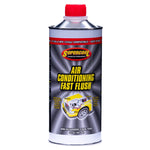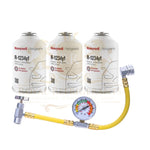You have no items in your shopping cart.
Everything You Need to Know About Automotive Refrigerant for HVAC and Automotive Applications
In both HVAC and automotive air conditioning systems, refrigerants are the lifeblood of cooling performance. They are responsible for absorbing heat from one area and releasing it elsewhere, enabling effective temperature regulation. In the automotive industry, refrigerants play a critical role in ensuring cabin comfort, defogging windows, and improving driving safety in hot climates. Understanding automotive refrigerants—their types, functions, properties, and best practices—is essential for technicians, vehicle owners, and HVAC professionals alike.
This article explores everything you need to know about automotive refrigerants, including how they work, their applications, key types, safety considerations, and the future of refrigerant technology.
What Is an Automotive Refrigerant?
An automotive refrigerant is a chemical compound used in a vehicle’s air conditioning (AC) system to absorb and transfer heat, thereby cooling the air inside the vehicle. It circulates through a closed-loop system consisting of components such as the compressor, condenser, expansion valve, and evaporator.
The refrigerant changes state between gas and liquid as it moves through the system, absorbing heat from inside the vehicle and releasing it outside. This continuous cycle is what keeps your car cool and comfortable, even in extreme heat.
Originally, automotive air conditioning systems used R-12 (dichlorodifluoromethane), a chlorofluorocarbon (CFC) refrigerant known for excellent performance. However, due to its ozone-depleting properties, R-12 was phased out and replaced with newer, more environmentally friendly options.

How Automotive Refrigerants Work
The process of automotive air conditioning relies on the refrigerant’s ability to change states and transfer heat efficiently. Here’s how it works:
- Compression: The refrigerant gas is compressed by the compressor, raising its pressure and temperature.
- Condensation: The high-pressure gas moves to the condenser, where it releases heat and condenses into a liquid.
- Expansion: The liquid refrigerant passes through an expansion valve or orifice tube, dropping in pressure and temperature.
- Evaporation: In the evaporator, the refrigerant absorbs heat from the cabin air and evaporates back into a gas, cooling the air that flows into the vehicle.
This cycle repeats continuously as long as the AC system is running. Without refrigerant, this heat exchange would not occur, and the system would fail to cool the interior.
Types of Automotive Refrigerants
Over the years, several types of refrigerants have been used in automotive systems. Each has different environmental impacts, thermodynamic properties, and compatibility requirements.
1. R-12 (CFC)
- Used in vehicles built before the mid-1990s.
- Excellent cooling performance but harmful to the ozone layer.
- Phased out due to environmental regulations.
2. R-134a (HFC)
- Introduced as a replacement for R-12.
- Non-ozone-depleting and widely used in vehicles from the mid-1990s to the 2010s.
- Still common today, but has a relatively high global warming potential (GWP ~1430).
3. R-1234yf (HFO)
- A hydrofluoroolefin refrigerant with a very low GWP (<1).
- Now standard in most new vehicles due to strict environmental regulations.
- Offers similar performance to R-134a with significantly less environmental impact.
4. R-744 (CO₂)
- A natural refrigerant with no ozone depletion and extremely low GWP.
- Used in some high-end or specialized automotive systems.
- Requires high-pressure systems and is less common but growing in popularity.
Applications in Automotive and HVAC Systems
While automotive refrigerants are primarily used in vehicle air conditioning systems, their principles and functions overlap with those in HVAC applications. Automotive refrigerants are designed to operate in compact, mobile systems that face vibration, temperature fluctuations, and changing load conditions.
In addition to cooling the cabin, refrigerants in vehicles serve several key purposes:
- Defogging and defrosting windows: By reducing humidity inside the cabin.
- Improving passenger comfort: Maintaining a stable and cool temperature in all driving conditions.
- Enhancing system performance: Modern refrigerants improve compressor efficiency and reduce energy consumption.
HVAC systems, though larger and stationary, rely on the same fundamental thermodynamic processes and often use similar refrigerant types, adapted for different capacities and applications.
Environmental Considerations
Environmental impact is a major factor in refrigerant selection. Older refrigerants like R-12 were phased out because they depleted the ozone layer. While R-134a solved that issue, its high GWP contributes to global warming. Modern refrigerants such as R-1234yf and R-744 are designed to minimize environmental impact while maintaining or improving system performance.
Regulatory frameworks like the Montreal Protocol and Kigali Amendment have accelerated the transition to low-GWP refrigerants. Technicians must be aware of these regulations and follow proper recovery, recycling, and disposal practices to comply with environmental laws.
Safety and Handling Guidelines
Because refrigerants operate under pressure and can cause harm if mishandled, following safety procedures is crucial:
- Wear protective gear: Use gloves and goggles to prevent skin and eye injuries.
- Avoid mixing refrigerants: Each type has specific properties and lubricant requirements; mixing can damage the system.
- Proper storage: Store cylinders upright in cool, dry, and well-ventilated areas.
- Use certified equipment: Proper recovery and recycling tools prevent leaks and contamination.
- Follow labeling and identification standards: Always verify the refrigerant type before servicing a system.
Future Trends in Automotive Refrigerants
The future of automotive refrigerants is focused on sustainability, efficiency, and regulatory compliance. Alternatives like R-1234yf and R-744 are leading the transition toward environmentally responsible solutions. Manufacturers are also exploring new blends and natural refrigerants that combine high performance with minimal climate impact.
As vehicle technology advances — including the growth of electric and hybrid vehicles — refrigerant systems are evolving to meet new efficiency and environmental standards while maintaining reliable cooling performance.
Conclusion
Automotive refrigerants are essential for maintaining comfort, safety, and performance in modern vehicles. They enable efficient cooling, control humidity, and support defrosting systems, making them critical to driver and passenger comfort. Over the decades, refrigerants have evolved from ozone-depleting CFCs to environmentally friendly HFOs and natural alternatives, reflecting a shift toward sustainability and regulatory compliance.
Whether you are servicing an older vehicle, working on modern automotive systems, or exploring HVAC applications, understanding the types, functions, and handling practices of automotive refrigerants is key. As the industry moves toward more eco-friendly solutions, staying informed about current technologies and future trends will ensure optimal performance and environmental responsibility.
 English
English







